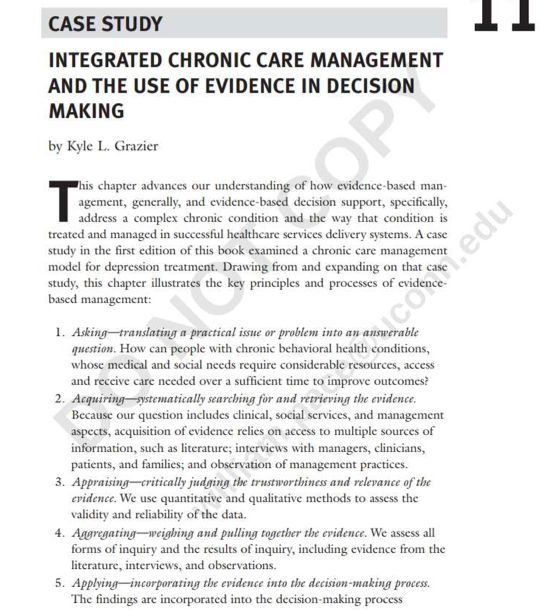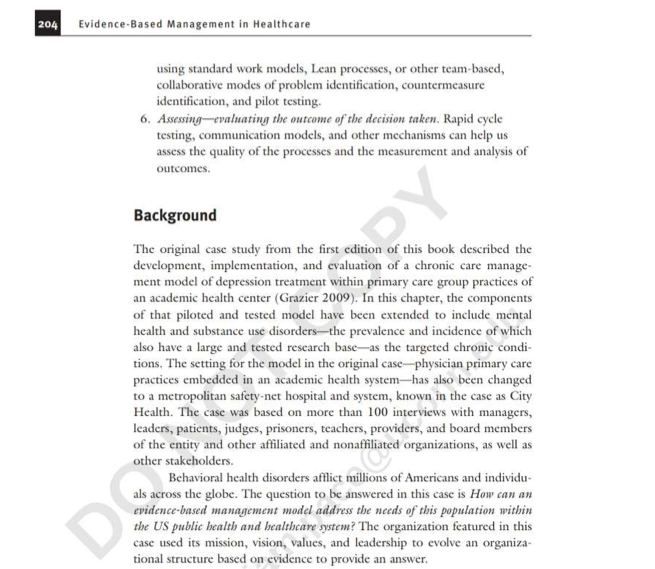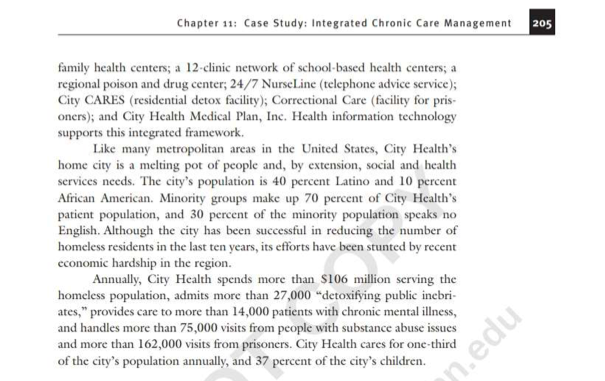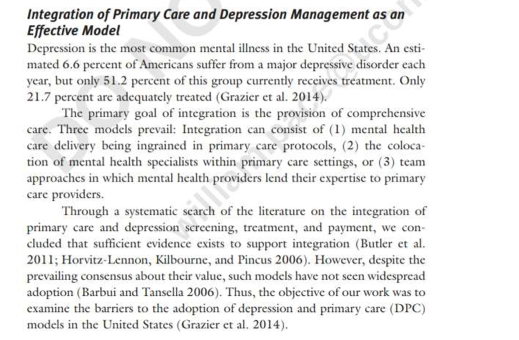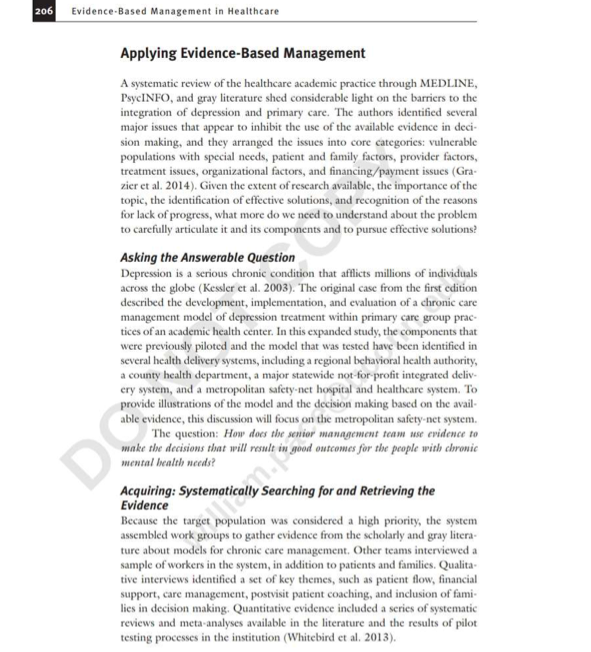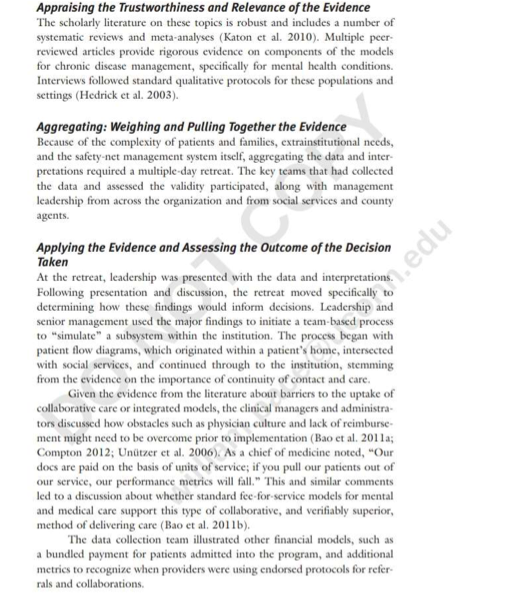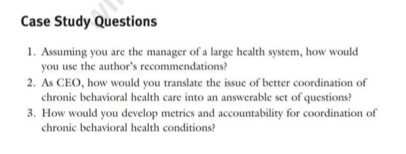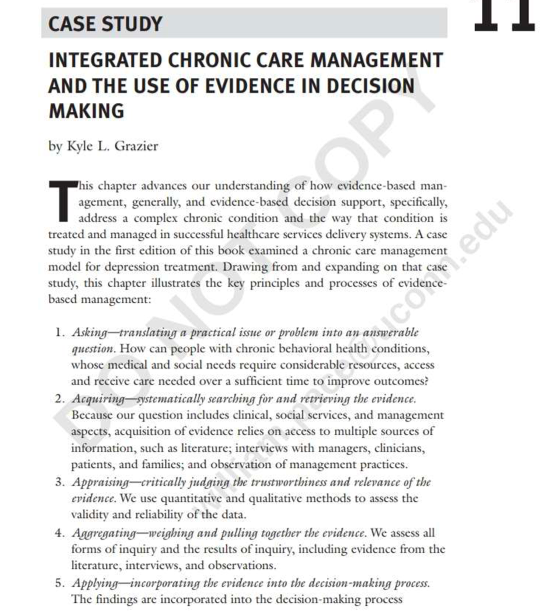
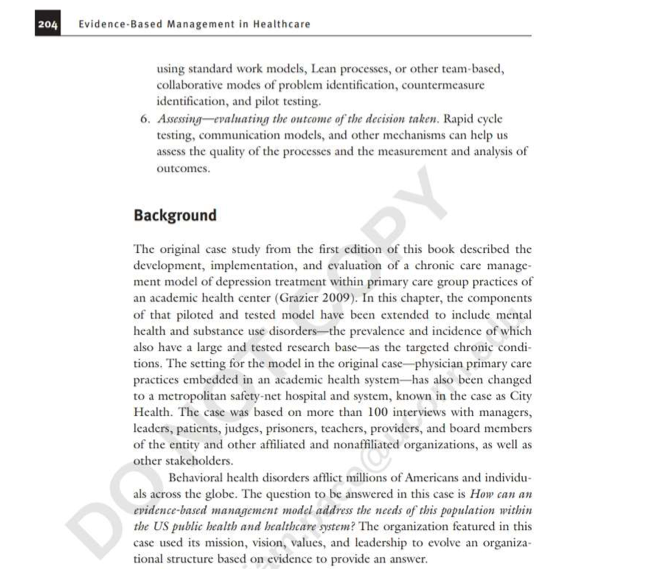

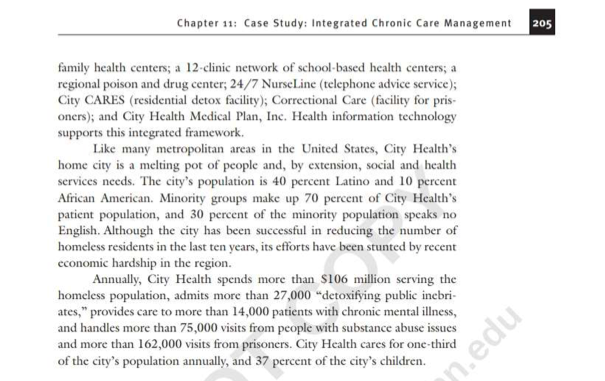
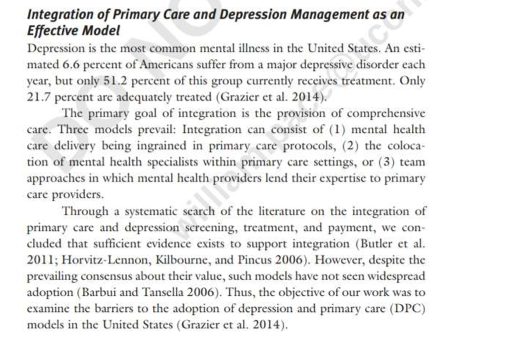

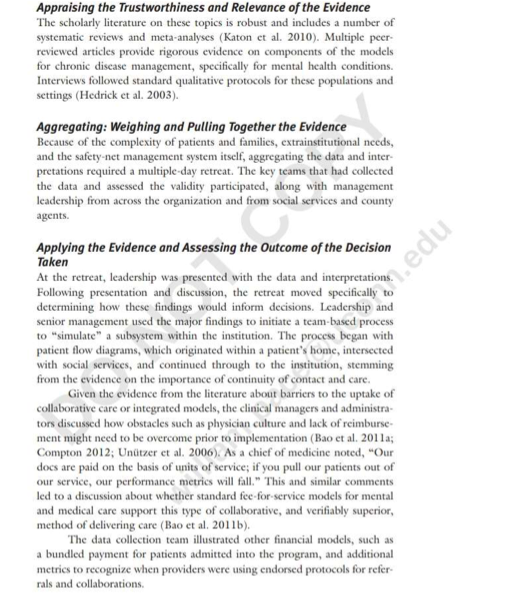

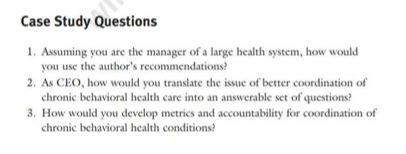
please read through case study and help answer the 3 case study questions at the end
CASE STUDY TT INTEGRATED CHRONIC CARE MANAGEMENT AND THE USE OF EVIDENCE IN DECISION MAKING by Kyle L. Grazier T his chapter advances our understanding of how evidence-based man- gement, generally, and evidence-based decision support, specifically, address a complex chronic condition and the way that condition is treated and managed in successful healthcare services delivery systems. A case edu study in the first edition of this book examined a chronic care management model for depression treatment. Drawing from and expanding on that case study, this chapter illustrates the key principles and processes of evidence- based management: 1. Asking-translating a practical issue or problem into an answerable question. How can people with chronic behavioral health conditions, whose medical and social needs require considerable resources, access and receive care needed over a sufficient time to improve outcomes? 2. Acquiring-systematically searching for and retrieving the evidence. Because our question includes clinical, social services, and management aspects, acquisition of evidence relies on access to multiple sources of information, such as literature; interviews with managers, clinicians, patients, and families; and observation of management practices. 3. Appraising-critically judging the trustworthiness and relevance of the evidence. We use quantitative and qualitative methods to assess the validity and reliability of the data. 4. Aggregating-weighing and pulling together the evidence. We assess all forms of inquiry and the results of inquiry, including evidence from the literature, interviews, and observations. 5. Applying-incorporating the evidence into the decision-making process. The findings are incorporated into the decision-making process204 Evidence-Based Management in Healthcare using standard work models, Lean processes, or other team-based, collaborative modes of problem identification, countermeasure identification, and pilot testing. 6. Assessing-evaluating the outcome of the decision taken. Rapid cycle testing, communication models, and other mechanisms can help us assess the quality of the processes and the measurement and analysis of outcomes. Background The original case study from the first edition of this book described the development, implementation, and evaluation of a chronic care manage- ment model of depression treatment within primary care group practices of an academic health center (Grazier 2009). In this chapter, the components of that piloted and tested model have been extended to include mental health and substance use disorders-the prevalence and incidence of which also have a large and tested research base-as the targeted chronic condi- tions. The setting for the model in the original case-physician primary care practices embedded in an academic health system-has also been changed to a metropolitan safety-net hospital and system, known in the case as City Health. The case was based on more than 100 interviews with managers, leaders, patients, judges, prisoners, teachers, providers, and board members of the entity and other affiliated and nonaffiliated organizations, as well as other stakeholders. Behavioral health disorders afflict millions of Americans and individu- als across the globe. The question to be answered in this case is How can an O evidence-based management model address the needs of this population within the US public health and healthcare system? The organization featured in this case used its mission, vision, values, and leadership to evolve an organiza- tional structure based on evidence to provide an answer.The Organization: City Health City Health and Hospital Authority is the largest safety-net provider in the state. At the core of City Health's multilayered mission is the delivery of high-quality acute, maintenance, and preventive care to all city and county residents, regardless of their ability to pay. Although it is the public health entity of the city government, City Health controls the operation, funding, and initiatives of its integrated structure, which comprises the following: a 500-bed hospital with a Level 1 academic trauma center; a 911 medical response system; the City Public Health Department; an 8-clinic network ofChapter 11: Case Study: Integrated Chronic Care Management 205 family health centers; a 12-clinic network of school-based health centers; a regional poison and drug center; 24/7 NurseLine (telephone advice service); City CARES (residential detox facility); Correctional Care (facility for pris- oners); and City Health Medical Plan, Inc. Health information technology supports this integrated framework. Like many metropolitan areas in the United States, City Health's home city is a melting pot of people and, by extension, social and health services needs. The city's population is 40 percent Latino and 10 percent African American. Minority groups make up 70 percent of City Health's patient population, and 30 percent of the minority population speaks no English. Although the city has been successful in reducing the number of homeless residents in the last ten years, its efforts have been stunted by recent economic hardship in the region. Annually, City Health spends more than $106 million serving the homeless population, admits more than 27,000 "detoxifying public inebri- ates,"provides care to more than 14,000 patients with chronic mental illness, and handles more than 75,000 visits from people with substance abuse issues u and more than 162,000 visits from prisoners. City Health cares for one-third of the city's population annually, and 37 percent of the city's children.Integration of Primary Care and Depression Management as an Effective Model Depression is the most common mental illness in the United States. An esti- mated 6.6 percent of Americans suffer from a major depressive disorder each year, but only 51.2 percent of this group currently receives treatment. Only 21.7 percent are adequately treated (Grazier et al. 2014). The primary goal of integration is the provision of comprehensive care. Three models prevail: Integration can consist of (1) mental health care delivery being ingrained in primary care protocols, (2) the coloca- tion of mental health specialists within primary care settings, or (3) team approaches in which mental health providers lend their expertise to primary care providers. Through a systematic search of the literature on the integration of primary care and depression screening, treatment, and payment, we con- cluded that sufficient evidence exists to support integration (Butler et al. 2011; Horvitz-Lennon, Kilbourne, and Pincus 2006). However, despite the prevailing consensus about their value, such models have not seen widespread adoption ( Barbui and Tansella 2006). Thus, the objective of our work was to examine the barriers to the adoption of depression and primary care (DPC) models in the United States (Grazier et al. 2014).206 Evidence-Based Management in Healthcare Applying Evidence-Based Management A systematic review of the healthcare academic practice through MEDLINE, PsychFO, and gray literature shed considerable light on the barriers to the integration of depression and primary care. The authors identified several major issues that appear to inhibit the use of the available evidence in deci- sion making, and they arranged the issues into core categories: vulnerable populations with special needs, patient and family factors, provider factors, treatment issues, organizational factors, and financing/payment issues (Gra- zier et al. 2014). Given the extent of research available, the importance of the topic, the identification of effective solutions, and recognition of the reasons for lack of progress, what more do we need to understand about the problem to carefully articulate it and its components and to pursue effective solutions? Asking the Answerable Question Depression is a serious chronic condition that afflicts millions of individuals across the globe (Kessler et al. 2003). The original case from the first edition described the development, implementation, and evaluation of a chronic care management model of depression treatment within primary care group prac- tices of an academic health center. In this expanded study, the components that were previously piloted and the model that was tested have been identified in several health delivery systems, including a regional behavioral health authority, a county health department, a major statewide not-for-profit integrated deliv cry system, and a metropolitan safety-net hospital and healthcare system. To provide illustrations of the model and the decision making based on the avail- able evidence, this discussion will focus on the metropolitan safety-net system. The question: How does the senior management team use cridence to O make the decisions that will result in good outcomes for the people with chronic mental health needs? Acquiring: Systematically Searching for and Retrieving the Evidence Because the target population was considered a high priority, the system assembled work groups to gather evidence from the scholarly and gray litera- ture about models for chronic care management. Other teams interviewed a sample of workers in the system, in addition to patients and families. Qualita- tive interviews identified a set of key themes, such as patient flow, financial support, care management, postvisit patient coaching, and inclusion of fami- lies in decision making. Quantitative evidence included a series of systematic reviews and meta-analyses available in the literature and the results of pilot testing processes in the institution (Whitebird et al. 2013).Appraising the Trustworthiness and Relevance of the Evidence The scholarly literature on these topics is robust and includes a number of systematic reviews and meta-analyses (Katon et al. 2010). Multiple peer- reviewed articles provide rigorous evidence on components of the models for chronic disease management, specifically for mental health conditions. Interviews followed standard qualitative protocols for these populations and settings (Hedrick et al. 2003). Aggregating: Weighing and Pulling Together the Evidence Because of the complexity of patients and families, extrainstitutional needs, and the safety-net management system itself, aggregating the data and inter- pretations required a multiple-day retreat. The key teams that had collected the data and assessed the validity participated, along with management leadership from across the organization and from social services and county agents. lu Applying the Evidence and Assessing the Outcome of the Decision Taken At the retreat, leadership was presented with the data and interpretations. Following presentation and discussion, the retreat moved specifically to determining how these findings would inform decisions. Leadership and senior management used the major findings to initiate a team-based process to "simulate" a subsystem within the institution. The process began with patient flow diagrams, which originated within a patient's home, intersected with social services, and continued through to the institution, stemming from the evidence on the importance of continuity of contact and care. Given the evidence from the literature about barriers to the uptake of collaborative care or integrated models, the clinical managers and administra- tors discussed how obstacles such as physician culture and lack of reimburse- ment might need to be overcome prior to implementation (Bao et al. 201 1a; Compton 2012; Unuitzer et al. 2006). As a chief of medicine noted, "Our does are paid on the basis of units of service; if you pull our patients out of our service, our performance metrics will fall." This and similar comments led to a discussion about whether standard fee-for-service models for mental and medical care support this type of collaborative, and verifiably superior, method of delivering care (Bao et al. 201 1b). The data collection team illustrated other financial models, such as a bundled payment for patients admitted into the program, and additional metrics to recognize when providers were using endorsed protocols for refer- rals and collaborations.Conclusion This process of evidence-based management and decision support resulted in a six-month pilot program, requiring measurement of processes and outcomes, analysis, and expansion to a second-stage program that was larger and longer.Case Study Questions 1. Assuming you are the manager of a large health system, how would you use the author's recommendations? 2. As CEO, how would you translate the issue of better coordination of chronic behavioral health care into an answerable set of questions? 3. How would you develop metrics and accountability for coordination of chronic behavioral health conditions









